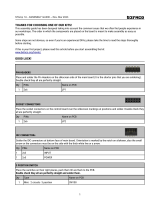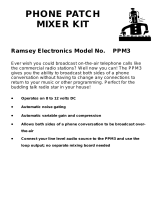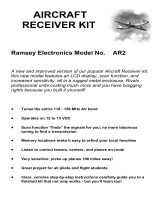Page is loading ...

RAMPAGE V1.4 - ASSEMBLY GUIDE – Rev. Oct 2022
THANKS FOR CHOOSING ONE OF OUR KITS!
This manual has been written taking into account the common issues that we often find people experience in our workshops. The order
in which the components are placed on the board is meant to make assembly as easy as possible.
Some steps are not obvious, so even if you're an experienced DIYer please read the steps thoroughly before starting. You will be
soldering both boards at the same time.
If this is your first project, please read this article before you start assembling the kit:
www.befaco.org/howto/
GOOD LUCK!
RESISTORS
Color code can be difficult to identify, we strongly recommend to use a multimeter.
Qty
Value
Code
Name on PCB
42
100k
Brown, black, black, orange, brown
R6, R8, R9, R10, R11, R14, R15, R18, R23, R24, R26, R28, R30, R32,
R33, R34, R35, R37, R38, R41, R42, R48, R49, R54, R56, R57, R59,
R61, R69, R80, R81, R85, R110, R111, R112, R115, R120, R121,
R128, R131, R148, R149
22
10k
Brown, black, black, red, brown
R17, R21, R22, R31, R46, R55, R60, R63, R66, R67, R71, R75, R82,
R83, R84, R87, R116, R117, R122, R124, R145, R147
15
1k
Brown, black, black, brown, brown
R79, R88, R100, R101, R102, R103, R105, R106, R118, R119, R123,
R125, R134, R135, R140
10
2k2
Red, red, black, brown, brown
R43, R44, R45, R47, R104, R107, R108, R109, R136, R137
8
110k
Brown, brown, black, orange, brown
R2, R3, R50, R51, R113, R114, R126, R127
7
4K7
Yellow, violet, black, brown, brown
R70, R73, R77, R78, R129, R130, R139
6
560k
Green, blue, black, orange, brown
R1, R4, R12, R27, R72, R74
6
1M
Brown, black, black, yellow, brown
R19, R36, R39, R40, R65, R76
4
22k
Red, red, black, red, brown
R68, R86, R132, R133
4
24k
Red, yellow, black, red, brown
R138, R142, R143, R146
4
3M
Orange, black, black, yellow, brown
R13, R16, R20, R29
2
180k
Brown, gray, black, orange, brown
R53, R64
2
470k
Yellow, violet, black, orange, brown
R58, R62
2
4M7
Yellow, violet, black, yellow, brown
R141, R144
1
20k
Red, black, black, red, brown
R52
1
75k
Violet, green, black, red, brown
R25
1
10M
Brown, Black, Black, Green, brown
R5
1

RAMPAGE V1.4 - ASSEMBLY GUIDE – Rev. Oct 2022
DIODES
Solder the diodes observing their polarity. The black or white line on the diode must match with the white line on the
diode symbol on the PCB silkscreen.
Qty
Value
Name on PCB
27
1N4148 (orange)
D1, D2, D3, D4, D5, D6, D7, D8, D9, D10, D11, D12, D13, D14, D15, D16, D17, D18, D19, D20,
D21, D24, D25, D100, D101, D102, D103
2
1N5817 (black)
D22, D23
FERRITE
To solder the two ferrite beads use a recycled resistor leg passed through each ferrite and proceed as if it were a
resistor. Ferrite beads don't have polarity. Leave some space between the ferrites and the board, so that there is
sufficient room to comfortably fit the power connector later.
Qty
Name on PCB
2
FERRITE+, FERRITE-
ICs
First place the sockets (taking care to orientate them properly – the notch on one end of the IC should match the image
on the silkscreen) and solder them into their correct positions.
Next place the ICs in their respective sockets (again taking note of their orientation – the notch on the top of the IC must
match that of the socket and silkscreen).
Qty
Value
Name on PCB
8
TL074
IC1, IC2, IC3, IC4, IC5, IC6, IC7, IC8
Buen trabajo! You’ve already made it quite far through the build. How are your focus
and energy levels? Do you think a 15 minute break would better prepare you for the
rest of the build (this is a big one!)? Maybe you could call someone you haven’t
talked to in a while or do something useful like debate politics on facebook or look
at videos of cats being jerks?
2

RAMPAGE V1.4 - ASSEMBLY GUIDE – Rev. Oct 2022
CAPACITORS
Identifying capacitors can be quite tricky. Codes stated are orientative, please take a look at this guide for help
identifying capacitors: http://www.wikihow.com/Read-a-Capacitor
Qty
Value
Code
Name on PCB
20
100n
104
C3, C4, C5, C7, C8, C12, C13, C14, C17, C18, C19, C21, C25, C26, C27,
C28, C31, C32, C102, C103
2
100p
101/100
C20, C22
2
560p
561
C10, C11
4
10n Polyester
10nK
C106, C107, C108, C109
2
47n Polyester
47nK
C100, C101
2
470n Polyester
.47K
C104, C105
2
2n2
WIMA 2200
C15, C16
TRANSISTORS
Be sure they are orientated correctly. The curved and flat sides of the silkscreen outline of the transistor on the PCB must
match that of the transistor’s body.
Qty
Value
Name on PCB
8
2n3904
T1, T2, T3, T4, T100, T101, T102, T103,
2
2n3906
T104, T105
ELECTROLYTIC CAPACITORS
Values are written on the side of the capacitor. Mind their polarity (The long leg of the capacitor is the positive (+)).
Qty
Value
Code
Name on PCB
2
10uf
10uf
C29, C30
SOCKET CONNECTORS
Place the Socket connectors at positions “TO_CON_A” and “TO_CON_B” on the control board and solder. Double check
they all are perfectly straight. Cut them flush to the PCB to make room for the faders.
PIN HEADERS
Place and solder the Pin Header on the silkscreen side at “CON_A” and “CON_B”on the main board. It is the shorter pins
that you are soldering. Double check they all are perfectly straight.
3

RAMPAGE V1.4 - ASSEMBLY GUIDE – Rev. Oct 2022
POWER CONNECTOR
Solder the power connector at “POWER” ensuring it is facing out from the edge of the PCB.
TRIMMERS
Solder the two 10k trimmers at “SYMETRY_A” and “SYMETRY_”B with the screws facing the edge of the PCB.
FADERS
Solder the faders onto the PCB at the positions indicated by the silkscreen on the opposite side of the board to most of
the components (but the same side as the two trimmer potentiometers you previously soldered).
Qty
Name on PCB
4
FALL_POT, FALL_POT_B, RISE_POT, RISE_POT_B
SPACERS
Secure the spacers onto the CONTROL PCB (through the holes with silver outlines) with the main body of the spacer on
the component side, and the nut on the opposite.
Bravo! You’re nearly at the end, but the next part is critical and takes a good bit of concentration. If
you’re feeling a bit strained a break would definitely help. Did you know that if you click the 1st
lowercase link in the main text of any wikipedia article, and repeating the process in subsequent
articles, you will usually end up on the Philosophy page?
FRONT PANEL COMPONENTS MOUNTING TIPS:
Now we will proceed to mount the jacks, potentiometer, switches and LEDs. This part of the assembly is CRITICAL. Please
take your time and read the following instructions carefully.
These components must NOT be soldered until they are placed on the PCB and fully attached to the front panel.
There are two reasons for this:
The height of the panel components are not all the same. Because of this, if not attached properly before
soldering, they will not stay properly seated against the panel. This might cause mechanical stress reducing their
life expectancy and in the worst case cause them to break.
The second reason is that it is very difficult to align the components to the holes if the panel is not positioned
prior to soldering. In the case of the LEDs, they are almost impossible to set to the correct height without
reference to the front panel.
MINI-JACKS
Place the mini-jacks on the PCB ensuring they are on the side with the silkscreen but don't solder them until the front
panel is in place, with all nuts screwed to it. This way it's easier to solder them in the right position. Keep in mind that
the front panel holes are quite narrow and it is almost impossible to place it with all the components already soldered.
4

RAMPAGE V1.4 - ASSEMBLY GUIDE – Rev. Oct 2022
POTENTIOMETERS
Place the potentiometers on the PCB. Do not place them all the way down, leave them loose and... don't solder them yet!
Qty
Type
Name on PCB
2
Dual (6pin) 10K
SHAPE_A, SHAPE_B
1
Single (3pin) 1M
CROSSFADER
SWITCHES
Remove the two nuts and the tabbed washer from the toggle switches. Discard one nut and the tabbed washer, but keep
one nut for securing to the front panel later. Place the four toggle switches on the PCB but don't solder them yet.
You will know which ones are the two and three position switches because when switching, two will have just two
positions it can rest in and the other two will have a third rest position (in the center).
Remove and discard the nut and the washer from the push button. Fit the push button onto the PCB but again...don’t
solder it yet.
Qty
Type
Name on PCB
2
Single two position
CYCLE_A, CYCLE_B
2
Single tree position
RANGE_1, RANGE_2
2
Push Button
M_TRIG_A, M_TRIG_B
LEDs
Place the LEDs onto the PCB minding their polarity, but don't solder them until the front panel is in place. This is the only
way to solder them in the right position.
The long leg is the positive and the short the negative. On the PCB the square pad indicates the negative side and there
is a + symbol to indicate the positive.
Qty
Name on PCB
9
F_A_LED, F_B_LED, LED_A, LED_A>B, LED_B, LED_MAX, LED_MIN, R_A_LED, R_B_LED
FRONT PANEL
Attach the front panel adjusting the parts one by one if necessary until it fits. At this point a pair of fine tweezers can be
helpful.
To Finish:
- Screw in the parts in this order: A) Mini-jacks B) Switches C) Pots D) Push buttons
- Ensuring all of the above parts are flush with the panel then you can finally solder them!
- Next, adjust the LEDs so that they are flush with the panel and solder them.
- Connect the main PCB to the control PCB by threading the 2x M3 screws through the main PCB and securing
them to the 2 spacers. The main PCB should be orientated so that the component side is facing towards the front panel.
- Put the knobs on the potentiometers and the red end-caps on the switches/faders.
5

RAMPAGE V1.4 - ASSEMBLY GUIDE – Rev. Oct 2022
CALIBRATION
Sometimes, due to the tolerance of the potentiometer, the response of the SHAPE pot may not be quite
symmetrical. If this is the case, adjust SYMETRY_A and SYMETRY_B trimmers as required.
To do this:
1. Connect the Rampage's OUT A to an oscilloscope. A software oscilloscope on your computer is
fine but in this case the signal needs to be attenuated to avoid clipping. If attenuation is needed
you can use the MAX OUT in place of OUT A and adjust the amplitude with the BALANCE pot
2. Set RANGE switch A to MID (bottom position).
3. Set the CYCLE Switch A to CYCLE (Top position).
4. Push the manual trigger A ( TRIGG) button, to put your rampage into oscillation.
5. Set RISE and FALL faders at minimum.
6. Turn the SHAPE A pot to the center (so you have a perfect triangle wave on your scope). Check if
rise and fall times are equal. If so you are done. If not go to the next step.
7. Turn the SYMETRY_A trimmer and try to match (as much as possible) the rise and fall times.
8. Repeat the previous steps for SYMETRY B.
ENJOY YOUR NEW BEFACO MODULE!
6

RAMPAGE V1.4 - ASSEMBLY GUIDE – Rev. Oct 2022
7

RAMPAGE V1.4 - ASSEMBLY GUIDE – Rev. Oct 2022
8
/
















